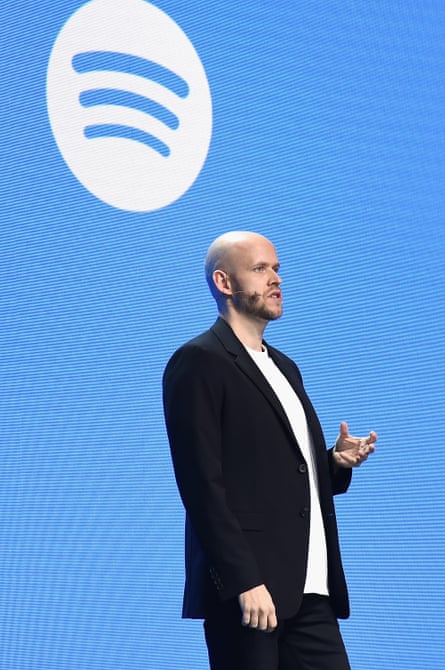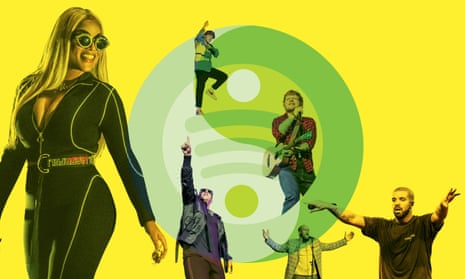The case for Spotify
The year is 2008. Now You’re Gone by Basshunter has spent its fifth week at No 1 and you can’t get enough of it. Your options are as follows: head to the shops and buy the single on CD, which doesn’t feel very on-demand; buy it as a download, the quality of which is as flimsy as Basshunter’s subsequent career; navigate through a labyrinth of occasionally pornographic popups to download it illegally; or sit through Scouting for Girls five times until it comes on the radio.
Ten years on, Spotify has erased these costly or frustrating scenarios. You can instantly access not just Now You’re Gone, but deep cuts from Basshunter’s oeuvre such as From Lawnmower to Music or his oft-overlooked Christmas single Jingle Bells (Bass). And, indeed, the majority of popular music made by anyone ever.
The result is music’s most radically democratic era. While adverts between songs jarringly juxtapose the beauty of art with the brutality of capital, it is at least free to listen to them. Thanks to Spotify and YouTube, no one with internet access – 90% of the UK – needs to pay for music, an important and seismic shift from the vinyl, CD and download eras when, for many people, music ownership was a luxury or treat. For £9.99 – the going price of one newly released CD album in 2008 – you can have uninterrupted access for a month.

You can already hear the effects of this democracy on music itself. The global profile of non-Anglophone pop has risen, from K-pop band BTS to Puerto Rican star Daddy Yankee, in part thanks to this levelled playing field; the multicultural hybrid music of stars such as Stefflon Don feels like the natural result of a culture that can access anything, anytime. Critics point out that you don’t own the music you pay Spotify for, but effectively rent it, although the “ownership” of digital files was always pretty illusory and underwhelming anyway – and, as anyone who has tried to copy a library of iTunes files from one device to another, a teeth-gnashing faff. As the parallel demise of Blockbuster Video and, er, print media shows, most people value convenience over physicality when it comes to film, news and music. It can also be argued that Spotify’s quality is lower than that of a CD, which is true, and the muso in me trembles to think how many people are listening to Spotify on its low, data-preserving quality, which sounds as if the songs have been irradiated. But its 320kbps “high quality” setting will satisfy all but the most sensitive listener.
Spotify speaks to this silent majority of music fans. Audiophiles, object fetishists, anti-capitalists, musicians – these groups noisily protest Spotify, but are marginal compared with the number of ordinary listeners, who never read the liner notes in the first place. For many people, music is just for mood, something to work, exercise or have sex to – situations that Spotify usefully caters to with playlists such as Productive Morning, Extreme Metal Workout and 90s Baby Makers.
It is a badge of pride for musos to say that Spotify’s machine-learning algorithms – when you listen to a track and it recommends things you might also like – don’t cover their cosmopolitan taste. But there are plenty more people who have relatively narrow taste, for whom – in a world where not everyone has the time or inclination to read up on new music – this kind of recommendation is really cherished. And if you do happen to have catholic taste, or fannish obsession, there are some very deep back catalogues to go down (even, should you so desire, Basshunter’s). There are debates to be had over revenue sharing and the acts it chooses to promote, but Spotify’s free, total access makes it essentially utopian. Ben Beaumont-Thomas
The case against Spotify
If I compiled the off-record remarks from my interviews over the past decade, the majority would concern Spotify – namely how much artists hate it. “Please don’t put that in,” they panic after slagging it off. “I really need it to support my new album.” And they do: Spotify is a kingmaker.
After the early 2000s doldrums, the recent music industry revenue boom is thanks to the rise in streaming. It is well known that artists don’t see much of this. Spotify’s royalty rate is notoriously low. The top 10% of artists dominate 99% of streams – as Ed Sheeran getting 16 tracks in the Top 20 after the release of ÷ showed. Still, Spotify’s patronage – putting artists in its powerful playlists, which drive streams – is crucial. Musicians can’t afford to complain.

At a relatively affordable £9.99 a month for an ad-free subscription, Spotify benefits the consumer more than the artist – superficially. Its exploitative relationship with musicians has trickle-down effects. The most basic is that any artist who can’t afford to make music is not going to be making much more of it – or they will have to tour for longer (costing their health and creativity) and find alternative revenue streams to survive. But just as musicians realised they couldn’t afford to be sniffy about “selling out”, after the puritanical 90s, Spotify undermined that undesirable alternative, too. As critic Liz Pelly writes in an essay for the Baffler, brands don’t have to pay to use songs on adverts if they want to piggyback an act’s cred – they can put them on branded playlists without asking permission or paying a penny.
Setting aside the issue of money, these playlists have fundamentally changed the listening experience. Spotify prides itself on its personalised recommendations, which work by connecting dots between “data points” assigned to songs (from rap, indie, and so on, to infinite micro-genre permutations) to determine new music you might like. Its model doesn’t code for surprise, but perpetuates “lean-back” passivity. There is no context on the platform, merely entreaties to enjoy more of the same: “You like bread? Try toast!”
It limits music discovery and the sound of music itself. Singles are tailored to beat the skip-rate that hinders a song’s chances of making it on to a popular playlist: hooks and choruses hit more quickly. Homogenous mid-tempo pop drawing from rap and EDM has become dominant: New York Times pop critic Jon Caramanica regularly disparages this sound as “Spotifycore”.
The algorithm pushes musicians to create monotonous music in vast quantities for peak chart success: hence this year’s tedious 106-minute Migos album, Culture II, and Drake’s dominance. Add in Spotify’s hugely popular artists with no profile outside the platform, widely assumed to be fake artists commissioned by Spotify to bulk out playlists and save on royalties, and music appears in danger of becoming a kind of grey goo.
Spotify looks like a neutral platform but behaves like a gatekeeper. It faced a backlash this year after censoring R Kelly and XXXTentacion for their alleged acts of violence against women (only to grossly promote XXX after his murder). Why were only black men censored when many white male rockstars have violated women?
It continually perpetuates such inequality: a report by Pelly found that despite the “woke optics of playlists like Feminist Friday”, women are underrepresented on its most popular playlists. (Meanwhile, Drake benefited from Spotify’s first “global artist takeover”, his face and music appearing on every editorialised playlist when he released this year’s Scorpion.) These function as echo chambers, popularity begetting more support, the antithesis of musical democracy.
Look: I pay my £9.99 a month. I use Spotify to make playlists for friends’ weddings and to compile 80s curios I discover on TOTP reruns. The genie isn’t going back in the bottle. But we can be responsible listeners (I buy albums I listen to more than five times) and hold Spotify to account because the people it is meant to benefit can’t. Any platform that intimidates the creators that underwrite its business is truly dystopian. Laura Snapes

Comments (…)
Sign in or create your Guardian account to join the discussion